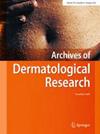HSV-1 inhibits melanogenesis of PIG1 cells through downregulation of VN1R5/ERK pathway
Abstract
Herpes simplex virus type 1 (HSV-1) is an ubiquitous pathogen that can infect humans through skin or mucous regions. This study was to explore the effects and underlying mechanism of HSV-1 as examined within the human epidermal melanocyte cell line, PIG1. Our results showed that following HSV-1 infection, PIG1 cells shrank and acquired a rounded shape, while the numbers and lengths of their dendrites decreased and melanogenesis was inhibited. Meanwhile, the HSV-1 receptors (nectin-1, herpes virus entry mediator, paired immunoglobulin-like type 2 receptor alpha) and phospho-extracellular signal-regulating kinase (p-ERK) were all substantially decreased, while vomeronasal type-1 receptor 5 (VN1R5) increased. Results of RNA interference and protein inhibitor assays revealed that knockdown of VN1R5 increased the expression of p-ERK and microphthalmia-associated transcription factor (MITF), while an inhibition of ERK decreased VN1R5 expression. Taken together, our study provides the first evidence that HSV-1 can infect human normal melanocytes and inhibit melanogenesis through VN1R5/ERK pathway.


 求助内容:
求助内容: 应助结果提醒方式:
应助结果提醒方式:


